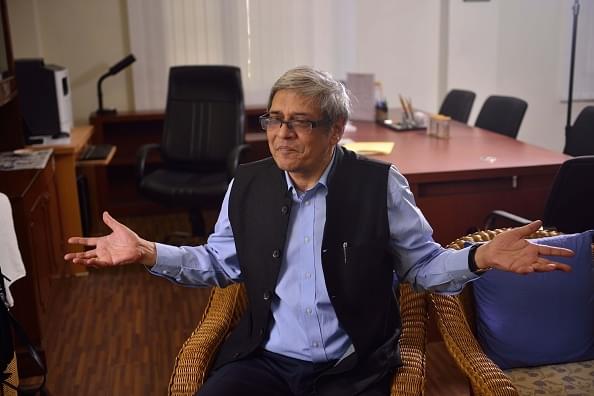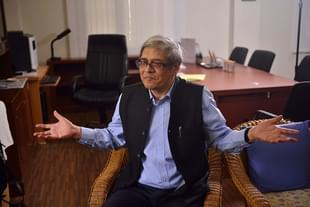Economy
Rail Minister’s Numbers Optimistic, Options In Choice of Technology Limited: Bibek Debroy
Suraj Gupta
Feb 27, 2016, 09:45 PM | Updated 09:45 PM IST
Save & read from anywhere!
Bookmark stories for easy access on any device or the Swarajya app.


- Rail Development Authority should be made statutory eventually if not immediately.
- Rail Minister’s numbers in the 2016-17 budget are optimistic.
- For technology acquisition, the railways have few options to choose from.
The hectic budget season is on and the railway budget was presented on Thursday (25, Feb). It has been praised and criticised by different people. To get a sense of the direction of the rail budget Swarajya spoke to economist and Niti Aayog member Bibek Debroy. He had submitted last year a well-researched 319-page long comprehensive report on the “Mobilization of Resources for Major Railway Projects and Restructuring of Railway Ministry and Railway Board.”
Debroy was kind enough to take some time out of his schedule and spoke to Suraj Gupta on the rail budget in the context of his recommendations and beyond. Here are some excerpts:
We want to know about the Rail Development Authority, which your committee had suggested. The rail minister has said that it will be at arm’s length from the rail ministry. How fast do you see the movement on it?
Debroy: The committee had recommended that the authority should be set up statutorily, because this gives it the independence. But if you just look at the speech, probably, you would not get a complete picture of what the minister wants to do. You should also take that in conjunction with the concept note floated by the ministry in January. The statute takes two to three years to happen so what the concept note seems to suggest is to do it executively in the interim. Now if it is going to be done executively, it’s not going to take that much time.

But if it is done by an executive order it would not have the command and the authority, isn’t it?
No, no. That’s the reason the committee had given a preference for it to be statutorily done. My preference continues to remain. But it takes time. Even in the committee several people had said why are you saying two to three years? Why can’t it be faster? So I can see the merit and the argument for it to be set up executively but I still have my reservations.
The rail minister has projected around 12% growth in gross traffic revenue. How realistic do you think the numbers are? The core sector growth still remains low.
You are asking one question but actually there are two questions. Firstly, in terms of the numbers of the rail budget, they add up not because of the tariff revenue, but because of what has been proposed on the non-tariff side. You are asking a question about the tariff side but there could be legitimate skepticism about the numbers from the non-tariff side also.
Let’s first talk about the tariff revenues
I personally think the numbers are optimistic. They did not materialise in 2015-16. Then I see no particular reason why they should materialise in 2016-17. It is not simply a question of growth and growth recovery. Even if growth recovers and the demand for transportation goes up, that does not mean that it would see increased share for the railways. Because the railways have sort of out-priced themselves in the freight segment, which is the remunerative part.
What about the non-tariff part?
I would say the same thing. They are optimistic.
You have said on your blog that there was no mention of human resources restructuring in the budget speech. What do you think is the problem, the union politics?
I sort of, will put it differently, it might be a good idea to do some things less visibly. Obviously the union part of it is one issue but it’s not just the unions, because some of it involves the railway board. May be, there is a reason to do it silently. Not with a lot of song and dance but incrementally. Putting it in the budget speech attracts attention, which may be good for investors but it could be counter-productive. I will, sort of, rephrase what you said. It’s not just the unions, it’s also the officers and also the railway board.
Your report talks about MoUs with the state governments, and the minister mentioned it. You have also talked about letting the sub-urban rail lines to be owned by the state governments.
Nothing very much has happened on that. There have been some JV’s (joint ventures) but I know they are not for sub-urban.
Then you must be disappointed, sir.
No, no, no… look... budget is just one day out of three hundred and sixty-five days. There are several things that should happen outside the budget. I won’t use the word disappointed. I will be disappointed if nothing happened.
About modernisation of the accounting system, how much progress has been made?
I know what has happened. But it’s not mentioned in the budget speech. I know, for example, it is being done on a pilot basis in the Ajmer division. I know it is being extended to north zone. I have no idea why it has not been mentioned in the budget speech. As in the Ajmer division and the north zone it was successful. I think in 2-3 years it should be possible to extend it on to the entire country. I suspect it was a conscious decision not to mention it.
So why do you think it was not mentioned?
May be they had some kind of problems, so they don’t want to commit themselves. I don’t have much idea.
Last February, the rail minister said he will have a total capital expenditure of Rs 8.5 lakh crore in five years. This year it is Rs 1.21 lakh crore. Last year it was Rs 1 lakh crore. So that makes it Rs 2.2 lakh crore, which means to meet his target he needs to spend more than Rs 6 lakh crore in the next 3 years, an investment of more than Rs 2 lakh crore every year on a continuous basis.
It’s always good to have a figure perhaps which you are unlikely to achieve. In the beginning I had thought the figure was a bit too high, to start off with. So it’s not possible to reach that figure.
Now about technological state of the railways. We are looking for the Spanish Talgo trains, France‘s Alstom is manufacturing coaches, the Chinese want a share of our high speed railways. So, which are the technologies we should actively seek for?
We actually don’t have too many options. Because technology increasingly doesn’t mean technology only in rolling stock. It is a completely integrated structure. It involves the tracks, the rolling stock, the signalling, the whole works, so it’s an entire package. Gone are the days when you can say that this technology is inter-changeable with that technology, doesn’t happen anymore. If you look at the world, there are only two to four countries which have technology. China, yes, but with China remember there have been IPR (Intellectual Property Rights) issues with western countries. I am not very sure until those IPR issues are sorted out whether we can afford to go to the Chinese. But essentially it’s a commercial decision, backed up by whatever loan agreements are available.
But behind the Mumbai-Ahmedabad high speed line which Japan is sponsoring there is some politics too, isn’t it?
I don’t know anything about the politics, but the terms of the Japanese loan are fairly attractive. The Chinese have never come up with such an attractive offer.

Not much has been mentioned in the budget on the safety issues. Railway accidents have not come down substantially.
You can’t have everything. Given a respectable operating ratio, I will not increase tariffs. I will have the pay commission. Where is the money to do anything significant about either safety or depreciation for that matter.
About the extra budgetary resources. We are taking loans from LIC, World Bank. Without adequate return on investment don’t we risk returning to the much-indebted Chinese railways?
Forget the Chinese, whatever loan I take, whatever be the rate of interest on that loan, I have to be in a position to repay that loan and today the railways projects are such that there aren’t really capable of paying that rate, whatever that rate be. This is the reason why when recently the IRFC (Indian Railway Finance Corporation) window was open, the railways did not use it.
So do you think the amount we have borrowed this year is problematic?
Part of the problem is I don’t know what the accounts tell. Since modern accounting rules are not followed, you actually don’t know the return you get on the project.
So is this year’s borrowing beyond your comfort level?
Look, you don’t have an option. The expenses are running high, you can’t raise the fares, so what option do I have? I don’t have enough degrees of freedom. So whatever problem we have, it’s only in the medium term that we can solve the problem, can’t think about the future.
Thanky ou very much sir.
Thankyou.
Suraj is a senior sub-editor at Swarajya. He is an economics grad from IIT-Kanpur.





